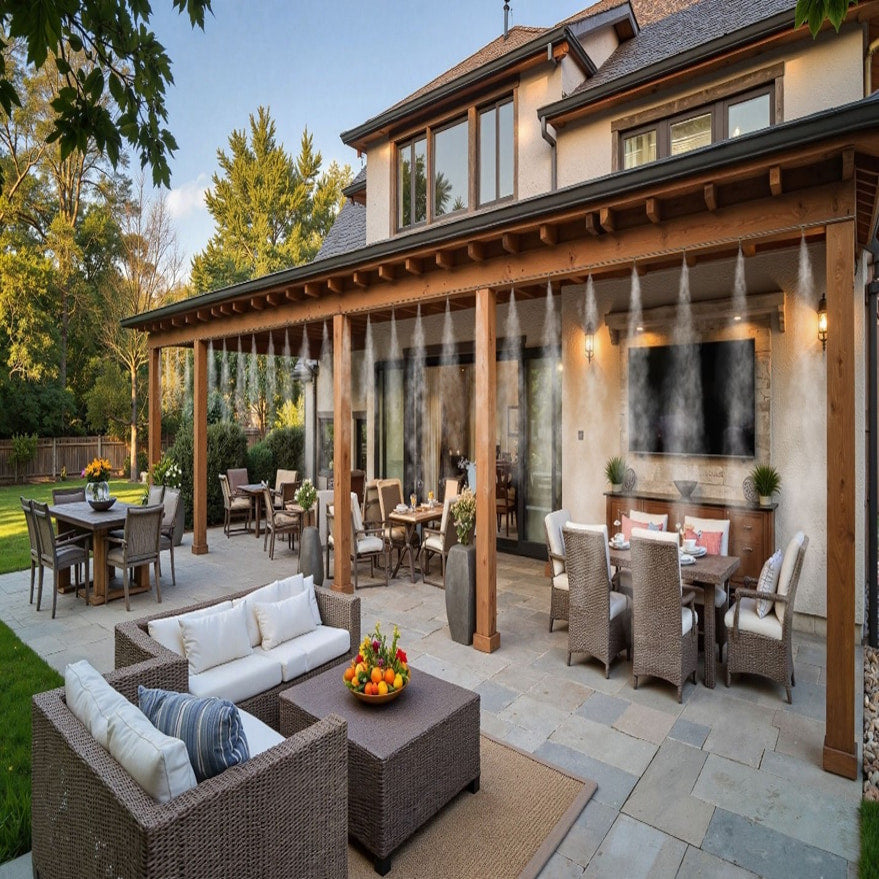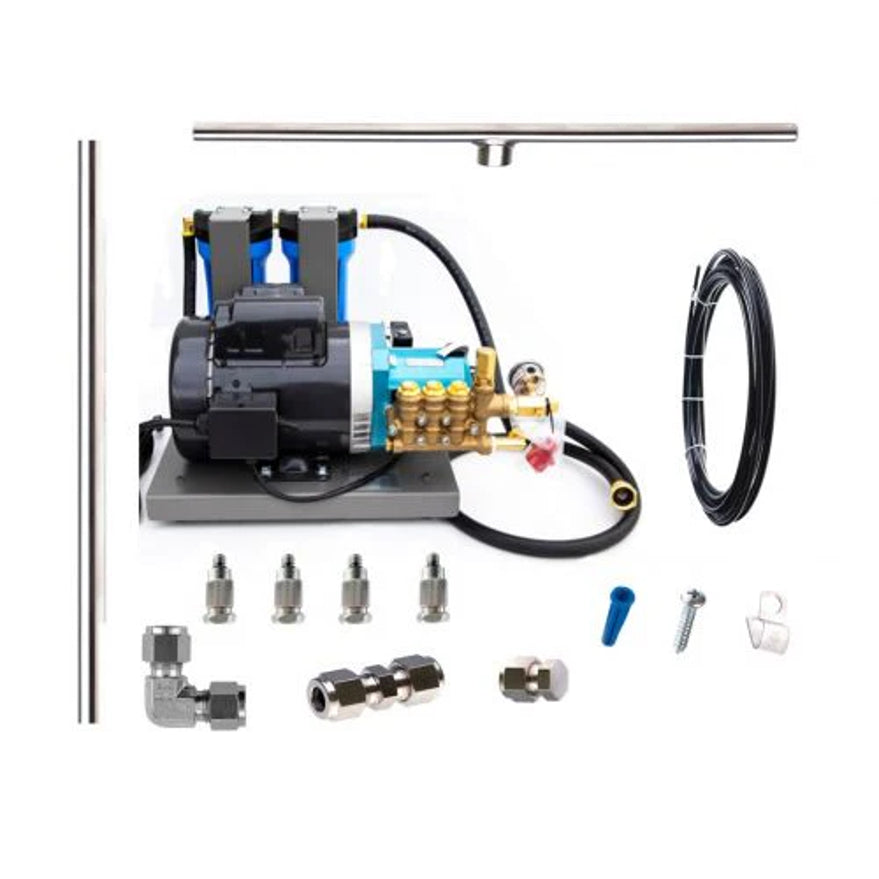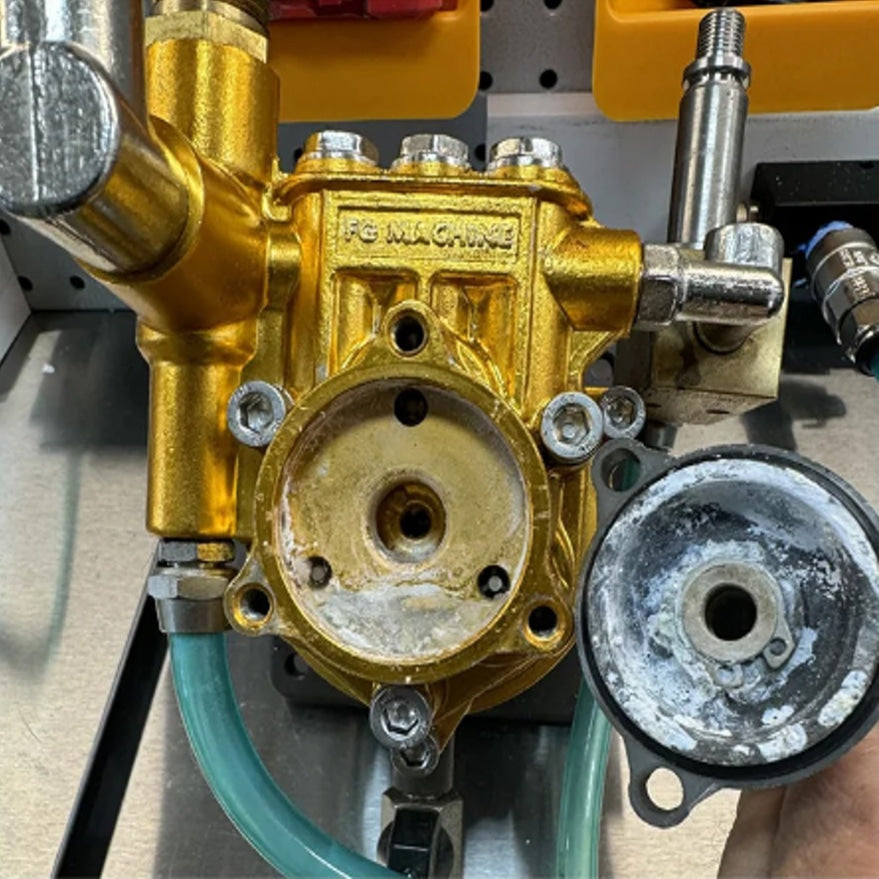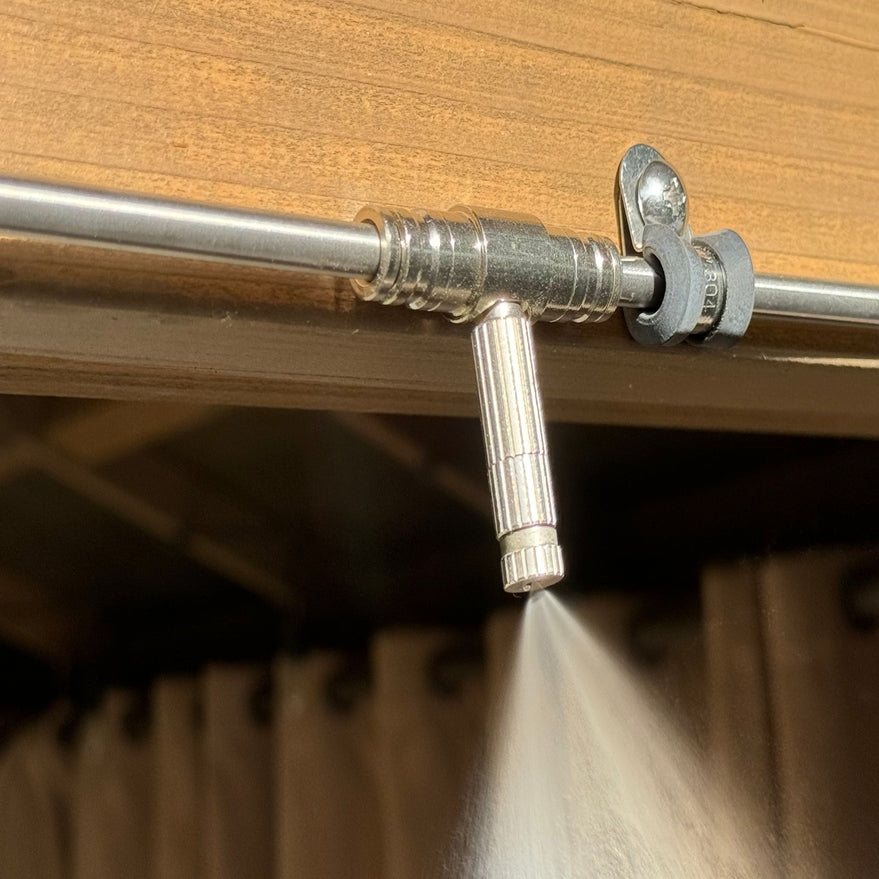📌 Key Takeaways
- Visual Integration Strategy: High pressure misting systems work best when their components align with existing outdoor structures like pergolas and patios, using coordinated finishes and colors to create visual coherence rather than obvious add-ons.
- Three-Component System Design:1000 PSI misting systems consist of three distinct parts—fan unit, external pump, and high-pressure line—requiring thoughtful placement planning, with the remote pump location offering design flexibility for entertainment areas.
- Targeted Cooling Zones: Ceiling misting fans create refreshing microclimates extending 12'-16' in diameter from 18"-24" fans mounted around 10' high, providing up to 25 degrees of cooling depending on temperature and humidity conditions without wetting.
- Climate-Optimized Performance:System effectiveness varies by local climate with particularly impressive results in drier climates, while nozzle selection during initial setup considers climate humidity levels and mounting height for optimal performance.
- Entertainment-Focused Design:Strategic system placement enhances hosting by creating invisible comfort boundaries that allow focus on guests rather than managing cooling equipment, with quiet operation supporting conversation-friendly environments.
These design principles enable homeowners to achieve both effective cooling and stunning outdoor aesthetics for year-round entertainment spaces.
The high-pressure misting system sits perfectly tucked behind the pergola beam, nearly invisible until the fine spray creates a magical cooling veil over the dining area. Your guests notice the comfort first—the way they can actually enjoy conversation outdoors during those blazing afternoon hours. Only later do they realize how seamlessly cooling technology blends with your outdoor design.
Creating an outdoor space that stays comfortable during hot weather while maintaining its visual appeal presents a unique challenge. Many homeowners worry that adding effective cooling will compromise their carefully planned outdoor aesthetics. The good news? When designed thoughtfully, 1000 PSI misting systems can enhance rather than detract from your outdoor living space's beauty.
This guide explores the fundamental design principles that allow you to achieve both effective cooling and stunning outdoor aesthetics, helping you create the comfortable outdoor sanctuary you envision for your family and entertaining needs.
Understanding Visual Integration Fundamentals
The key to successful misting system design lies in understanding how cooling elements can complement your existing outdoor décor. Rather than viewing misting components as necessary eyesores, consider them part of your overall design strategy.

Working with Natural Sight Lines
Your outdoor space already has natural visual pathways—where the eye travels when people first enter the area, and where it rests during conversation. High pressure misting systems work best when their components align with these existing patterns rather than fighting against them.
Overhead structures like pergolas, gazebos, and covered patios provide ideal integration opportunities. The framework that already exists for shade can easily accommodate misting lines, making the cooling system feel intentional rather than added as an afterthought. When misting components follow the same lines as your existing structures, they become part of the architectural story.
Component Integration and Technical Considerations
Modern high pressure misting systems consist of three distinct components that require thoughtful placement: the fan unit, external pump, and high-pressure line connecting them. The external pump, positioned remotely from the fan location, allows for flexible design options since it doesn't need to be directly adjacent to your entertainment areas. Factor in the location of your water source when planning pump placement to minimize exposed plumbing, and consider subtle grading if drainage is a concern in very humid conditions or enclosed spaces.
When planning installations that route high-pressure lines behind ceiling surfaces, proper sleeve protection using Pex or PVC ensures both system longevity and easy maintenance access. This technical requirement actually supports better aesthetics by keeping lines hidden and protected. While simpler line misting might be approachable for experienced DIYers, designs involving hidden lines behind ceilings or complex zoning often benefit from professional installation to ensure both performance and aesthetic integrity.
Color and Material Harmony
High pressure misting systems offer components in various finishes that can coordinate with your outdoor furniture and fixtures. Copper-colored fittings complement warm-toned outdoor settings, while brushed stainless steel works beautifully with contemporary designs. Black components virtually disappear against many backgrounds, especially when positioned along darker structural elements.
The goal isn't necessarily to make everything invisible—it's to create visual coherence. When misting system elements use similar materials or colors to your existing outdoor features, they contribute to rather than compete with your design aesthetic. Opting for high-quality components, like stainless steel or brass fittings where appropriate for your design, not only ensures visual coherence but also contributes to the system's longevity and sustained aesthetic appeal.
[ILLUSTRATIVE EXAMPLE]
Consider an outdoor dining area with a wooden pergola and wrought iron furniture. A 1000 PSI misting system using black tubing that follows the pergola's beam pattern while incorporating bronze-finished nozzles that echo the furniture's metal tones creates a cohesive look. The system becomes part of the design language rather than an obvious add-on.
[END EXAMPLE]
+-------------------------------------------------------------------------------------------------------+
💡 Quick Takeaways
- Component Alignment:High pressure misting systems integrate best when following existing overhead structures like pergolas and patios
- Three-Part Design:Systems consist of fan unit, external pump, and high-pressure line requiring coordinated placement planning
- Visual Coherence: Coordinated finishes and colors make misting components complement rather than compete with outdoor décor
+-------------------------------------------------------------------------------------------------------+
Planning Your Cooling Design Strategy
Effective misting system design starts with understanding how cooling needs align with your outdoor activity patterns. Different areas of your outdoor space serve different purposes, and your cooling strategy should reflect these varying needs.
Zoning for Function and Form
Entertainment areas require different cooling considerations than relaxation spaces. Dining zones benefit from gentle, consistent misting that provides comfort without interfering with food service. Lounge areas can accommodate ceiling misting fans that create refreshing microclimates extending 12'-16' in diameter from the center of the fan.
The best misting designs create invisible comfort boundaries. Guests should feel the cooling benefit—up to 25 degrees of cooling depending on temperature and humidity conditions—without being conscious of getting wet or hearing distracting equipment noise. High pressure systems excel at this because they produce finer mist with optimal evaporative cooling effects without wetting. Furthermore, consider if your future needs might change; some system designs offer more modularity, allowing for easier expansion of cooling zones later if planned for initially.
System Selection for Different Spaces
Ceiling misting fans work particularly well in areas that aren't suited for perimeter systems or in spaces that are especially wide or deep where perimeter system effects might not reach effectively. These 18"-24" fans, typically mounted around 10' high, provide cooling in specific, concentrated areas while maintaining design flexibility.
For spaces with existing ceiling fans, both traditional and misting options serve valuable purposes. Traditional fans provide comfort through air movement, while misting fans enhance this cooling effect by incorporating evaporative cooling technology.
Climate and Performance Considerations
The cooling effectiveness of high pressure misting systems varies based on local climate conditions, with particularly impressive results in drier climates. This occurs because drier air allows for more efficient evaporation, which is the key to the cooling process. However, these systems provide refreshing comfort across various climate conditions.
Nozzle selection during initial setup takes into account two basic parameters: climate humidity levels and mounting height of the nozzles. This initial configuration ensures optimal performance for your specific environment without requiring ongoing adjustments.
Seasonal Adaptability
Designing for year-round outdoor enjoyment means thinking beyond peak summer cooling needs. The most successful misting systems can be modified for different seasons and occasions without compromising their integrated appearance.
Planning for maintenance access ensures your beautiful design remains functional long-term. Components that are easy to reach for seasonal care maintain their performance and appearance over time. Ensure that chosen mounting locations for lines and nozzles allow for easy reach without requiring specialized equipment, which will simplify routine cleaning and seasonal preparation, such as nozzle cleaning/replacement or seasonal draining/winterization.
+-------------------------------------------------------------------------------------------------------+
💡 Quick Takeaways
- Cooling Zones:Ceiling misting fans create 12'-16' diameter cooling areas with up to 25 degrees temperature reduction
- Climate Performance:Systems work across various climates with particularly impressive results in drier conditions
- Strategic Placement:Different outdoor areas require different cooling approaches based on entertainment and relaxation needs
+-------------------------------------------------------------------------------------------------------+
Essential Design Elements for Outdoor Comfort
Creating truly comfortable outdoor environments requires balancing multiple design elements that work together seamlessly. Successful misting system integration considers how cooling technology interacts with shade, airflow, and social dynamics.

Layered Comfort Strategies
The most effective outdoor cooling combines high pressure misting with other comfort-enhancing elements. Shade structures reduce direct heat load, allowing misting systems to work more efficiently. Natural breezes help distribute cooled air and prevent humidity buildup in covered areas.
This layered approach often produces better results than relying solely on high-output cooling systems. When shade, airflow, and strategic misting work together, the overall comfort level exceeds what any single solution could achieve.
Creating Atmosphere Through Design
Beyond functional cooling, well-designed 1000 PSI misting systems contribute to the overall ambiance of outdoor spaces. Fine mist can create visual interest, especially when combined with outdoor lighting. The gentle operation of high pressure systems maintain conversation-friendly noise levels.
Some homeowners discover that misting systems enhance their landscape's beauty by providing supplemental moisture for nearby plants. This dual function—cooling people while benefiting vegetation—creates a more integrated outdoor ecosystem.
Entertaining Considerations
Social spaces have unique requirements that pure functionality doesn't address. Misting systems for entertainment areas need to enhance rather than complicate hosting duties. High pressure systems allow hosts and business owners to focus on guests rather than constantly managing cooling equipment.
Strategic placement ensures all seating areas receive comfortable cooling without creating wet spots. The superior evaporation characteristics of 1000+ PSI systems provide cooling benefits without concerns about clothing or personal comfort.
Guest comfort extends beyond temperature control. Well-designed high-pressure systems operate quietly enough to support conversation without requiring raised voices. The fine mist produced by these systems provides cooling benefits while maintaining the social atmosphere you've worked to create.
+-------------------------------------------------------------------------------------------------------+
💡 Quick Takeaways
- Layered Comfort: Combining misting with shade and airflow creates superior outdoor comfort compared to single solutions
- Entertainment Focus:High pressure systems allow hosts to focus on guests rather than managing cooling equipment
- Quiet Operation:Well-designed systems operate quietly enough to support conversation without disruption
+-------------------------------------------------------------------------------------------------------+
Planning Your Perfect Outdoor Cooling Solution
The transformation from a hot, underused outdoor space to a comfortable entertainment destination happens through thoughtful design that honors both function and beauty. Your outdoor sanctuary can provide the reliable cooling your family needs while maintaining the visual appeal that makes the space truly special.
Creating this balance requires patience during the planning phase, but the reward—year-round outdoor enjoyment that enhances rather than compromises your home's aesthetic—makes the careful consideration worthwhile. The cooling system that seemed like a complex challenge becomes an integrated part of your outdoor lifestyle.
Ready to transform your outdoor space into the comfortable haven you've envisioned? Start by evaluating which design principles resonate most with your current outdoor setup.
Frequently Asked Questions
Q: How do I know if a high-pressure misting system will look good in my outdoor space?
A: Focus on existing structural elements that can accommodate misting components. Spaces with pergolas, covered patios, or established overhead features typically integrate 1000 PSI misting systems most successfully. Consider whether your outdoor area has consistent color schemes or materials that misting components could complement.
Q: What should I consider when planning misting system placement?
A: Prioritize your primary seating and gathering areas for cooling coverage. Ceiling misting fans create effective cooling throughout a 12'-16' diameter area from the center of the fan. Plan for easy maintenance access and consider how the three-component system (fan unit, external pump, and high-pressure line) will integrate with your space when not in operation.
Frequently Unasked Questions
Q: How does misting system design affect the overall feel of outdoor entertaining areas?
A: Well-integrated high pressure misting systems create a resort-like atmosphere that guests often notice subconsciously. The cooling effect—up to 25 degrees depending on temperature and humidity conditions—allows longer, more comfortable gatherings, while the quiet operation actually enhances intimate conversation.
Q: What design mistakes do most people make when first planning outdoor misting systems?
A: Many homeowners focus exclusively on cooling power without considering visual integration, resulting in systems that work well but look obviously retrofitted. Another common oversight involves not planning for the three separate components of high-pressure systems—the fan unit, external pump, and connecting high-pressure lines—during the initial design phase.

 Free Shipping On All Orders Over $50
Free Shipping On All Orders Over $50 (916) 308-3856
(916) 308-3856





